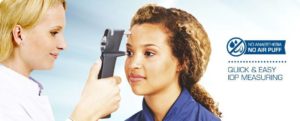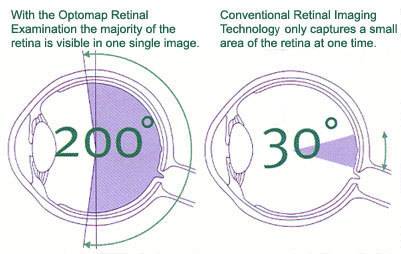iCare Tonometer
 iCare tonometers are based on unique, patented rebound technology, in which a very light and small probe is used to make a momentary contact with the cornea. The quick and painless measurement is barely noticed by the patient and any anesthesia or inconvenient air puffs are not needed at all. Icare technology has been proven accurate and reliable by several clinical studies. iCare Tonometers provide easy and intra-ocular pressure measurement.
iCare tonometers are based on unique, patented rebound technology, in which a very light and small probe is used to make a momentary contact with the cornea. The quick and painless measurement is barely noticed by the patient and any anesthesia or inconvenient air puffs are not needed at all. Icare technology has been proven accurate and reliable by several clinical studies. iCare Tonometers provide easy and intra-ocular pressure measurement.
Autorefractor
 An autorefractor or automated refractor is a computer-controlled machine used during an eye examination to provide an objective measurement of a person’s refractive error and prescription for glasses or contact lenses. This is achieved by measuring how light is changed as it enters a person’s eye.
An autorefractor or automated refractor is a computer-controlled machine used during an eye examination to provide an objective measurement of a person’s refractive error and prescription for glasses or contact lenses. This is achieved by measuring how light is changed as it enters a person’s eye.
This measurement is important for diagnosing certain eye conditions, such as astigmatism or corneal distortion, and it is very helpful for fitting contact lenses.
OPTOMAP Retinal Exam
In keeping with our mission to provid our patients with the most innovative technology, Eyecare Associates is excited to introduce the Optomap. It is used as part of your eye exam to take a digital scan of the back of you eye. It helps evalute the overall health of your retina and detect eye diseases such as diabetes, macular degeneration and even some types of cancer. It identifys the presence of any retinal lesions, such as holes, tears or detachments, which can present without any signs or symptoms and can cause permanent vision loss.
The Optomap Retinal exam:
- provides your doctor with a scan of the retina to confirm the health of your eye
- allows your doctor to detect the presence of disease early in its progression
- will be saved in your medical file enabling your doctor to make important comparisons during your annual eye exam
OCT Retinal Scan
An Optical Coherence Tomography scan (commonly referred to as an OCT scan) is the latest advancement in imaging technology. Similar to ultrasound, this diagnostic technique employs light rather than sound waves to achieve higher resolution pictures of the structural layers of the back of the eye.
A scanning laser used to analyze the layers of the retina and optic nerve for any signs of eye disease, similar to an CT scan of the eye. It works using light without radiation, and is essential for early diagnosis of glaucoma, macular degeneration and diabetic retinal disease.
With an OCT scan, doctors are provided with color-coded, cross-sectional images of the retina. These detailed images are revolutionizing early detection and treatment of eye conditions such as wet and dry age-related macular degeneration, Glaucoma, Retinal Detachment and Diabetic Retinopathy.
An OCT scan is a noninvasive, painless test. It is performed in about 10 minutes right in our office. Feel free to contact our Fort Collins eye care clinic to inquire about an OCT at your next appointment.
Visual Field Testing
Digital Retinal Imaging
Digital Retinal Imaging allows your eye doctor to evaluate the health of the back of your eye, the retina. It is used to detect diseases, such as, Diabetes and Macular Degeneration. It is critical to confirm the health of the retina, optic nerve and other retinal structures.
Many eye diseases, if detected at an early stage, can be treated successfully without total loss of vision. Your Retinal Images will be stored electronically. This gives the Doctor a permanent record of the condition and state of your retina. This is very important in assisting the Doctor to detect and measure any changes to your retina each time you get your eyes examined, as many eye conditions, such as Glaucoma are diagnosed by detecting changes over time.
Corneal Mapping
Corneal topography, also known as photokeratoscopy or videokeratography, is a non-invasive medical imaging technique for mapping the surface curvature of the cornea, the outer structure of the eye. Since the cornea is normally responsible for some 70% of the eye’s refractive power, its topography is of critical importance in determining the quality of vision.
The three-dimensional map is therefore a valuable aid to the examining ophthalmologist or optometrist and can assist in the diagnosis and treatment of a number of conditions; in planning refractive surgery such as LASIK and evaluation of its results; or in assessing the fit of contact lenses. A development of keratoscopy, corneal topography extends the measurement range from the four points a few millimeters apart that is offered by keratometry to a grid of thousands of points covering the entire cornea. The procedure is carried out in seconds and is completely painless.
Special thanks to the EyeGlass Guide, for informational material that aided in the creation of this website. Visit the EyeGlass Guide today!

